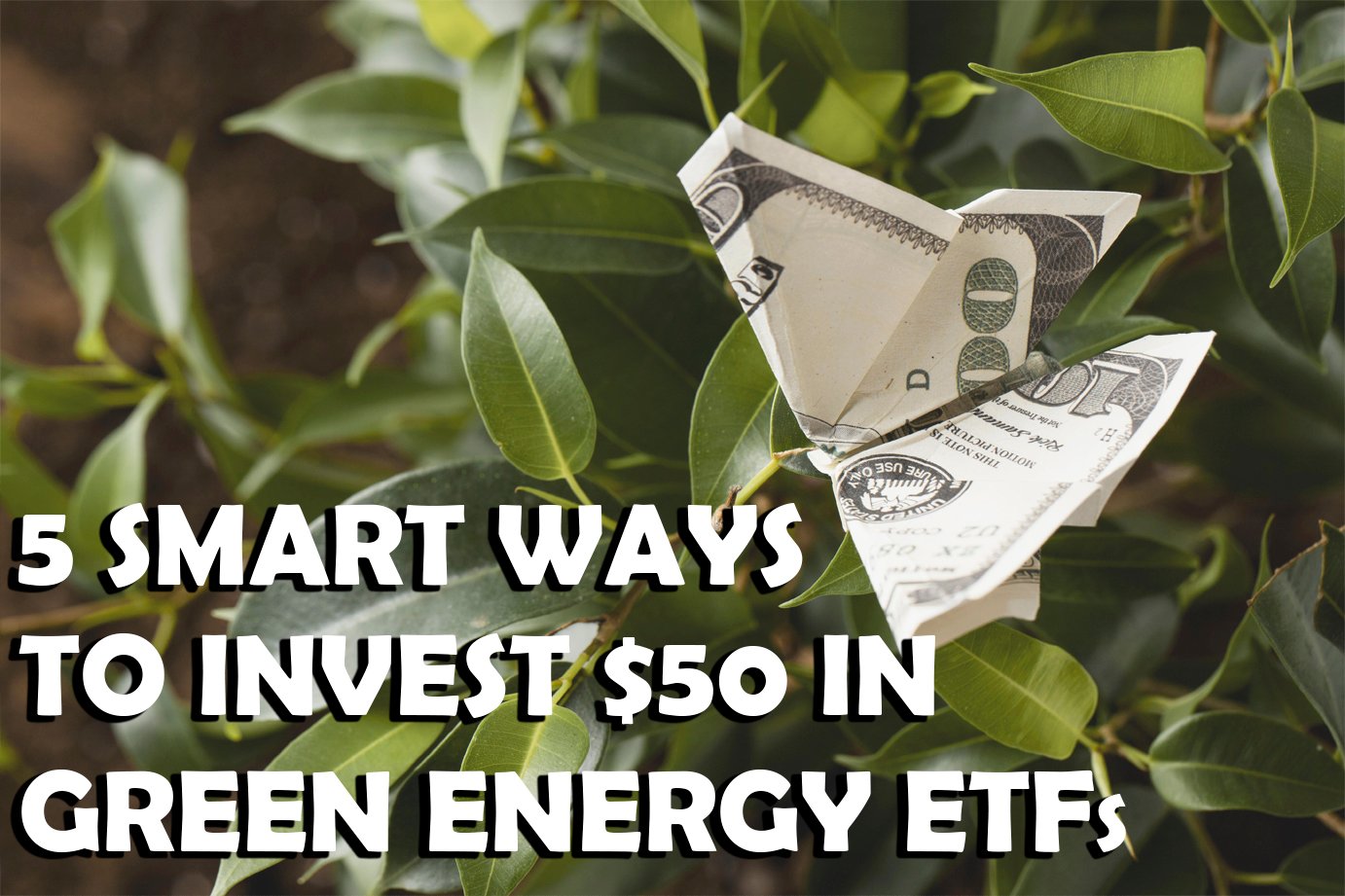Discover 5 smart ways to invest 50 dollar in green ETFs monthly. Start building sustainable wealth, support the planet, and grow your portfolio with confidence.
Introduction of Smart Ways to Invest $50
More people than ever in our modern times desire their investments to be what they care about—i.e., the planet. A prevalent myth, however, is that being favorable to your investment requires deep pockets or expertise. Most prospective investors are frightened even before they take steps because they think tens of thousands of dollars are required to give or initiate.
The truth is otherwise. With robo-investing programs, fractional shares, and micro-investing apps, it is now completely possible to begin building a sustainable investment portfolio on as little as $50 per month. If you are a young adult, college student, or simply a one who wants their money to align with their values, eco-investing has never been simpler.
And here, in this book, step by step, we’re going to illustrate the path of beginning small with green ETFs—Exchange-Traded Funds invested in businesses whose mission is to reduce carbon footprints, to encourage clean energy production, and to fund good environmental practice. You’ll learn what they are, how to select the best, where to put your money, and the advantages (and disadvantages) of this approach. We will invest your $50 and leverage it to produce wealth and a greener, sustainable world.
What Are Environmentally Friendly ETFs?
Green/sustainable ETFs or sustainable ETFs are exchange-traded funds that use money to invest in firms that contribute positively to the environment. These green ETFs can be opted for by investors who wish to accumulate their wealth while investing in companies that strive to create a positive impact in areas such as climate change, pollution, renewable energy, and environmentally friendly resource use. In contrast to investing in the regular market, green ETFs filter companies based on their environmental impact and will not invest in those firms involved in refining fossil fuels, wood, or other sectors that have been accused of harming the environment.
They’re basically the same as regular ETFs: they are a group of individual stocks, bonds, or securities collected and traded in the stock markets as a single share. The only difference here is that they choose sustainability. Climate-based ETFs focus on certain clean energy sectors—wind, solar, or hydroelectric—and others focus on highly rated Environmental, Social, and Governance (ESG) firms. ESG ETFs consider how the organization is treating management, workers, or local communities, but always puts its focus on environmental sustainability.
Green ETFs vary from each other in terms of purpose and style. For instance, Clean Energy ETFs invest in companies that are themselves producers of clean energy, such as wind farm owners or producers of solar panels. ESG ETFs utilize wider criteria, along with favoring companies taking lower-carbon routes and cleaner approaches. There are also carbon-neutral ETFs as an option, which offset the portfolio’s carbon footprint, and fossil fuel-free ETFs that invest elsewhere in oil, gas, and coal stocks. All of these various methods offer investors a lot of options depending on their environmental objectives and risk tolerance.
Some of the most popular green ETFs are the iShares Global Clean Energy ETF, tracking the global clean energy industry equities, the Invesco Solar ETF, carrying solar equities, and the SPDR S&P 500 ESG, following U.S. large-cap equities with good ESG ratings. They all have varying structures, performance histories, and cost ratios, so one must do their homework. Ultimately, green ETFs are a cost-effective, ethical, and highly profitable way to invest in a greener tomorrow.
Green ETFs by Category:
- Clean Energy ETFs invest in clean energy industries like solar, wind, hydro, etc.
- ESG ETFs (Environmental, Social, and Governance) address broader ethical concerns; however, they do have eco concerns as well.
- Fossil Fuel-Free ETFs offer investment in companies with zero investment in oil, gas, or coal.
Best Green ETFs to Invest in:
- iShares Global Clean Energy ETF (ICLN) – Invests in an international set of companies that produce clean energy.
- Invesco Solar ETF (TAN) – Invests in the rapidly changing solar power sector.
- SPDR S&P 500 ESG ETF (EFIV) – The harmony of ESG drivers within the S&P 500 universe where performance and principles converge.
Can You Start with Just $50 a Month?
For most, investing is something they shy away from because they believe they can’t invest because they don’t possess hundreds—or thousands—of dollars to be able to make it work. It is a myth that deters students, young adults, poor citizens, and even ecologists from investing in something they care about. But almost as fast as investing technology and fintech websites have appeared on the horizon, now it is completely possible to begin building a sustainable portfolio for an investment of only $50 per month—and green ETFs make it that much easier.
The old way of investing had minimums, broker fees, and buying whole shares. Let’s say you had a $150 stock or ETF—it cost the entire thing to invest. But fractional share investing turns it on its head now. Websites such as Robinhood, Fidelity, M1 Finance, Acorns, and Charles Schwab enable you to purchase half a share of an ETF or stock—so your $50 can pay for half an investment even if the entire share costs $200 or more. The apps also often charge zero commission trading, so the entire $50 goes entirely into your investment rather than into commissions.
Another philosophical foundation supporting individual investors is dollar-cost averaging (DCA). It’s a technique of investing a constant sum at periodic intervals, say $50 each month, regardless of the market’s activity. In a high market, your dollars will purchase fewer shares; in a low market, your dollars will purchase more. This strategy, in the long run, takes the bite out of market fluctuations and the agony of trying to “time the market.” It also declares one to be disciplined and structured of which supports long-run successful investing.
Let’s have some fun with some numbers. You’re contributing $50 a month and achieving an 8% average rate of return, historically aligned with long-run market performance—compounding interest, remember—when you’re done, you’d have about $7,600 in 10 years, and over $22,000 in 20. That should give you a sense of how even fairly modest contributions, over time and the magic of compounding returns, can add up to real sums.
Apart from the numbers, earning $50 or more from it brings you more than a financial increase—it brings you self-assurance. You know how to deploy investment funds, monitor market trends, and invest money properly. It breaks the perception of investing in something expensive because money is small, and develops the habit of doing so that may emerge after your salary is increased.
So go ahead, start at $50 a month—and when you invest in green ETFs, you’re not just building your wealth; you’re building a cleaner, greener world.
And one of the greatest things about investing nowadays is that brokerages such as M1 Finance, Fidelity, Robinhood, and Acorns have rendered the traditional roadblocks obsolete with fractional share investing. You don’t have to buy an entire share of a $200 ETF anymore—you can invest a fraction for $5, $10, or $50.
How Dollar-Cost Averaging Works:
This investing plan puts the same amount of money into your investments regularly (for me, $50 a month). In up or down markets, you put in money regularly. Even this strategy smooths out your cost over time and mitigates the risk of wild markets.
And small numbers do add up:
Assume you invest $50 monthly in an 8% average-per-year-returning green ETF. After 10 years, your account value may exceed $7,600—and you won’t even notice it.
5 Smart Ways to Invest 50 Dollar in Green ETFs
Step-by-Step explanation: How to Invest $50/Month in Green ETFs
✅ Step 1: Select a Brokerage or App
Begin by choosing a brokerage that offers fractional shares, no trading commission, and convenience. Some top choices are:
- Robinhood: Fee-less and minimalist mobile layout with simplicity and ease.
- M1 Finance: Robo-investing and creating individual portfolios.
- Fidelity or Charles Schwab: If you prefer old-school, traditional brokers.
- Acorns: Invests the spare change in ETF portfolios and rounds up your buys.
Ensure the site has eco-friendly ETFs and auto-contributions.
✅ Step 2: Create an Investment Account
Open your account after you have chosen your platform. You should have a choice of:
- Taxable Brokerage Account: Best for open-ended investing with no withdrawal limits.
- Roth IRA: Retirement savings, long-term investment, tax-free withdrawals.
To open an account is to associate a bank account, verify who you are, and identify your risk tolerance.
✅ Step 3: Select Your Green ETFs
Investigate ETFs by your goals. ESG scores, returns, and fees can be compared and contrasted using websites like Morningstar, ETF.com, or Yahoo Finance. Diversified green ETF sample portfolios might include:
- One green energy ETF with broad exposure (such as QCLN)
- One ESG aggregate ETF (such as EFIV)
- One industry (such as TAN for solar or PHO for water)
✅ Step 4: Set Up $50 a Month Contribution
Establish an automatic transfer from your checking account. Automatic doesn’t skip months and keeps you invested year-round—no matter how hectic life gets. Sites like M1 Finance provide easy automatic deposits and investments.
✅ Step 5: Review and Rebalance Every Year
Use integrated dashboards to examine performance and see if your green ETFs remain in line with your objectives. Once annually, rebalance when necessary—shifting funds to preserve your desired asset mix.
How to Choose the Best Green ETFs for You
The best green ETFs are not a question of choosing the most flashy fund—it’s a question of choosing the appropriate investment for you and your own values, goals, and risk tolerance. Even if you’re just a starter with $50 a month to start, you’d like money to work for you and the planet too. All green ETFs are not created equal, and metrics such as expense ratio, historical performance, and ESG disclosure make or break long-term results. These are the eight most important things to monitor when choosing top-performing green ETFs in your budget and belief.
1. Investment Purpose
Ensure that you have a purpose in mind for your investment before you select any fund. Do you want long-term retirement returns, medium-term savings, or short-term green guilt? Your purpose will decide the type of ETF that you’d prefer to target—some focus on steady growth, some aggressive clean-tech growth. Keeping your ETF in sync with your purpose reduces risk and simplifies your strategy.
2. Tolerance for Risk
Different green ETFs carry different risk profiles. Clean energy ETFs, for example, may have higher irrelevance compared to broad ESG ETFs due to the nature of emerging technologies. If you’re a coward, opt for funds with stable, diversified holdings. If you’re willing to face more ups and downs for potentially higher gains, tech-heavy green funds might be good for you.
3. Fund Holdings Transparency
An actual green ETF will state its largest holdings and how it screens for stocks. Check to make sure the fund doesn’t invest in fossil fuels, weapons, tobacco, or other businesses you don’t want to support. An open fund is a tell that the fund manager’s feet are on fire and your money means what you mean—not a wink-wink-marketing name.
4. Expense Ratio
Even tiny fees can nibble away at your returns in the long term, especially if you’re in a holding pattern for an extended period of time. Use ETFs that have expense ratios—i.e., less than 0.50%—to help keep more of your gains. Some ESG funds will charge a little extra to offset screening and research expenses, so pair similar funds to ensure you’re getting a bargain.
5. Performance History
The past doesn’t dictate, but it provides a good gauge. Look at a fund’s 1-, 3-, and 5-year histories. Examine whether they’re holding up and bucking down markets. While new green ETFs won’t have past history, mature funds can provide a sense of whether they will buck various market trends.
6. Index vs. Actively Managed
Green ETFs can be run passively (following an ESG index) or actively by professional fund managers. Passive funds will cost more and trade on the market. Actively managed funds can be profitable to a greater extent, but cost more and involve more risk. Select depending upon how much you would like managers to be actively engaged in selecting individual stocks.
7. ESG Scoring Method
ESG score systems vary across providers, so it’s interesting to know your ETF’s environmental performance score. Some use third-party measures like MSCI, and others have in-house systems. Good governance, lower footprint on the environment, and social responsibility equate to a high ESG score. Make sure the score is aligned with your values.
8. Sector & Geographic Exposure
Consider where the ETF is investing. There are U.S. tech-biased green ETFs, whereas others are allocating to global clean energy, European carbon-free stocks, or Asian water solutions. Investing in your portfolios across geographies and industries can decrease risk and leverage more prevalent green growth opportunities.
Tools and Resources to Stay on Track
- Investment Platforms: Robinhood, Fidelity, M1 Finance, Betterment
- Research Tools: ETF.com, Morningstar, Yahoo Finance
- Green Investment Blogs: The Impact Investor, GreenMoney Journal
- Calculators: Use compound interest calculators to see growth over time
Save these links to stay current, review your ETFs annually, and re-balance on new issues or ESG changes.
Advantages & Disadvantages
Advantages of Investing in Small-Palette Green ETFs:
✅ Common Values
You’re not just making your money, you’re investing in companies committed to reducing emissions, saving resources, and being creative about sustainability.
✅ Low Buy-In
Fractional investing and minimum-no platforms allow you to invest in a share of a green ETF for as low as $10.
✅ Diversification
An ETF holds dozens or even hundreds of stocks. Your $50 is not money in one company—it’s spread over a lot of them, cutting down on risk.
✅ Lower Risk Over Time
Dollar-cost averaging eliminates the impact of highs and lows in the market by eveninging out the buying.
✅ Financial Self-Assurance & Habit Creation
Gradual deposits over time instill self-control and lead to bigger contributions in the long run.
✅ Long-term Relief from Taxes
Contribute to a Roth IRA or similar fund and enjoy long-term tax savings.
Disadvantages and Challenges to Be Aware Of:
Clean industries such as clean energy are capricious, particularly at times of economic downturn.
Some ESG-thematic ETFs also come at a higher cost ratio than typical index funds, which will erode the returns over the long term.
❌ Greenwashing Issues
Not all that’s “green” is as wonderful as it’s made out to be. Some “green” ETFs invest in companies whose green credentials are questionable, so check the ETF portfolio and strategy.
❌ Falling Behind on the Environmental Score
While making direct donations to foundations will necessarily have an immediately visible positive impact, the positive impact of green ETF investing might not be immediately apparent.
❌ Slow Building of Wealth
Accumulating incrementally is $50/month, and thus discipline and restraint are needed.

FREQUENTLY ASKED QUESTIONS
Can I make recurring contributions of $50/month into green ETFs in a retirement account?
Absolutely! You can create Roth IRAs and schedule recurring transfers to ETFs on platforms such as Fidelity and M1 Finance.
Are ESG ETFs actually any good?
EREsque most of the overwhelming majority of most of the large majority of ESG ETFs actually have genuine sustainability impacts in the holdings they maintain, but always, always double-check fund holdings to ensure they are what you think.
Do I really require a few green ETFs?
Having 2–3 green ETFs (e.g., one clean energy, one ESG, one sector play) can reduce risk and equate to mean returns.
Is $50/month really enough to get wealthy?
Yes! Constant investing will pay off in the long term. Even $50/month can become a thousand in the future.
How do I avoid greenwashing while selecting ETFs?
Utilize resources like Morningstar’s ESG scores or ETF.com to see each ETF’s strategy and leading holdings.
Final Thoughts: Start Small, Think Big
You don’t need to be a multi-millionaire to make good with your money. Jumping with $50 a month in green ETFs is not only an option—it’s the sensible thing to do in the information age. Your monthly payments can accumulate over time, both to your own wealth and the planet.
Remember, sustainable investing is not about money; it’s about power. The earlier the better, the more powerful your dollars to create change. So scale up. Your $50 can be the beginning of a long-term, impactful money cycle.
References
- Morningstar ESG Ratings
- ETF.com Green ETF Guide
- U.S. Department of Energy: Clean Energy Facts
- GreenMoney Journal
- Compound Interest Calculator








